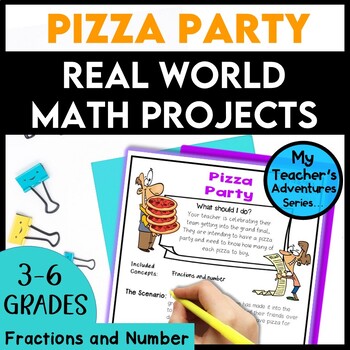Real World Math Project | Multiplying Fractions by Whole Number Grades 4th 5th 6
- PDF
Also included in
- Bring Real World experiences into your math lessons with these exciting Math PBL activities. The growing bundle math projects has been developed to be completed by teachers that have limited time. Each Math project covers a range of math skills and provides students with the opportunity to transferPrice $31.15Original Price $44.50Save $13.35
Description
Have your student beg to learn about fractions during your math classes! This real world math project will provide a chance for your students to practice their skills with finding, multiplying fractions by whole number and more...
Are you looking for the hook to get your students excited in math? Students love thinking about what their teacher's lives are like outside of school. This is how the "My Teacher's Adventures in series" was started. Let your students work on mathematical projects of fun adventures/ stories about possible scenarios that you as a teacher may have!
This mini math project covers a range of topics. It has been designed for students in grades 3 to 6, but could be ideal to engage middles school students that need revision. The project is designed to run between 2-3 lessons depending on how much time you wish to allocate to the tasks.
The projects are easy to follow and can either be teacher run or student driven.
Pizza Party: The teacher is having a pizza party to celebrate the grand final of their big game. They have decided to celebrate by inviting 20 family and friends over to watch the game. Students will work out the most popular pizza toppings, and then find out how many of each type of pizza they will need to buy for the 20 guests.
WHY USE THIS RESOURCE?
- The opportunity to enter YOUR OWN NAME, to build the connection/ hook with your students
- Engage students through story telling and purpose
- Have students transfer the math skills taught into real world scenarios
INCLUDED IN THIS RESOURCE:
- Student Project page with task and requirements
- Planning pages for students
- Worksheets to guide student learning
- Teacher assessment with links to CCS
- Self/ peer assessments
KEY MATH SKILLS INCLUDED IN THIS PROJECT:
- Fractions of a whole
- Simplest form/ equivalent fractions
- Problem solving
** Suitable for both USA and UK/ AUS classroom.
** Please note this resource allows you to edit your teacher name or use the standard 'your teacher' phrase. Otherwise it is not editable due to font/ clipart copyright.
THIS PROJECT CAN BE USED IN MANY WAYS, INCLUDING:
- At the end of a unit of work to test knowledge
- Fun Friday math lessons
- Group work
- For fast finishers
- Fun projects for students to complete for homework
More from the My Teacher's Adventures Math Series:
- Design a Guest House (3D shapes, nets, measurement)
- Dinner Party (money, budgeting)
- New Pet (tallies, graphs)
- Summer Vacation (money, budgeting, time)
- Pixel Art (Fractions, decimals)
Looking to SAVE money and buy the GROWING bundle of Projects?
Buy the Bundle and Save over 30%!
Related Products
★ Real World Mini Math Projects: 2D Alien Toy, Distance Learning
★ Real World Mini Math Projects: Marble Run, Distance Learning
★ Real World Mini Math Projects: Sports Statistics, Distance Learning
★ Real World Mini Math Projects: Wild Weather, Distance Learning
★ Middle School Student Run Business Project
★ Year 5 Business and Economics, Eco Tourism Project, HASS
★ Year 5 Business and Economics Australian Curriculum, HASS
~~~~~~~~~~~~~~~~~~~~~~~~~~~~~~~~~~~~~~~~~~~~~~~~~~~~~~~~~~~~~~~~
You may also be interested in the following resources:
Fast Finishers or End of Term Ultimate Challenge Book: Bronze Level
~~~~~~ Receive TPT credits to use on future purchases ~~~~~~
Go to your My Purchases page. Next to each purchase you'll see a Provide Feedback button, click it and you will be taken to a page where you can leave a quick rating and a short comment about the product. Each time you provide feedback, you’ll earn TPT credits that can be used for future purchases to save you money! Plus, the feedback you provide helps me make my products better suit your needs!
~~~~~~ How to Follow My Store to receive updates and special deals ~~~~~~
Click the green star beside my name at the top of this page OR at the top of my store page. Following me notifies you when I post a new item and you will receive emails when products are on sale.
Copyright information:
Purchasing this product grants permission for use by one teacher in his or her own classroom. If you would like to share with others, please purchase an additional license.
*I really value your feedback*
I try to go over the work carefully to ensure no errors, however, occasionally I might miss something. If you find an error please email me and I will fix it straight away. Thanks!






